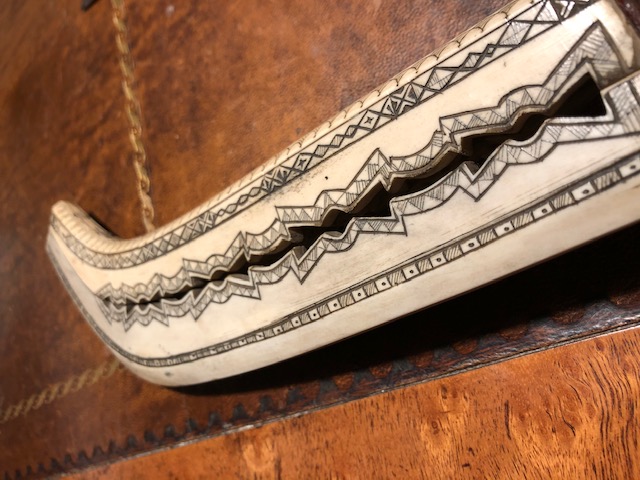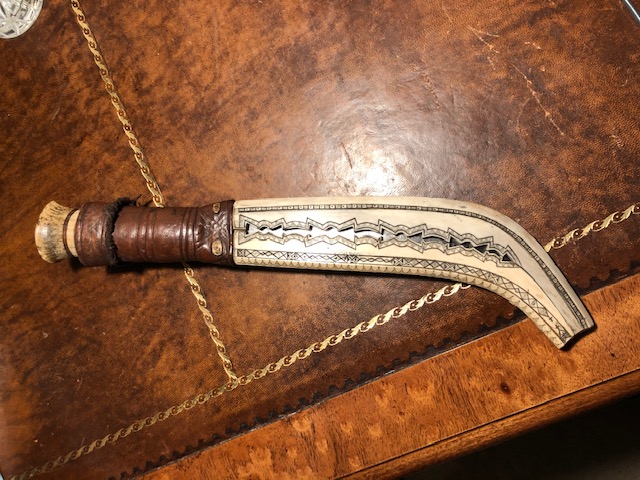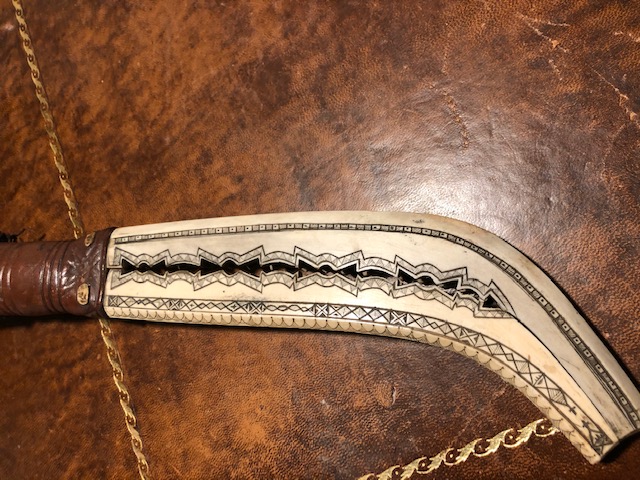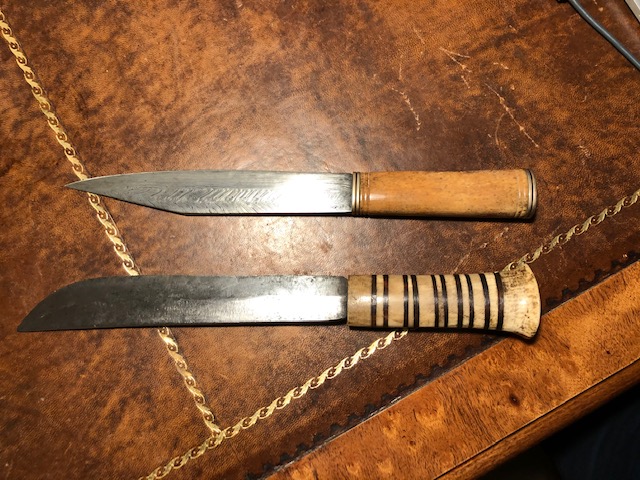| Author |
Message |
Daniel Parry

|
 Posted: Wed 26 Feb, 2020 4:15 pm Post subject: A Sami Knife Posted: Wed 26 Feb, 2020 4:15 pm Post subject: A Sami Knife |
 |
|
This is an off topic post for me, but apart from my usual rapier and smallsword collecting I have the other side of my study/den which is 'rest of the world'. I don't normally post anything about these things because they are an assortment of things from different countries which I happened to like.
I thought I would post this one which I got recently just because I really like it. And I think it would appeal to those who like Seaxs, as I do. It is a big Sami knife of traditional style, probably 19th century but could be early 20th century. Hard to tell with these.
I like it because I love scrimshaw work. I like it because of its similarity to Seaxs and general ultility/weapon knives.
Its a big knife but the original ones I have seen of this type have generally been bigger than the modern versions I have seen with short blades and bigger handles.
It's 13 inches in the scabbard. Out of the scabbard it's 12 inches, 8 inch blade, 4 inch handle. Handle I think is stag crown (reindeer probably ?) but with the edges filed down. Spaced with leather. Blade is as it appears, widening towards the point. Overall it feels like a lightish bowie knife.
What I love is the scabbard - made of two reindeer antler halves, cut into slabs and then hollowed to make the two halves of the scabbard. The halves are then glued and pegged (photo) with reindeer antler pegs through both sides.
I like these pieces because I can imagine the scrimshaw being done on dark Northern winter nights round a fire because there was nothing else to do but eat, tell stories, make things, carve things etc. So I can picture that, possibly the conceit of my imagination. But given my family were of Scandinavian origin and I grew up in the north of England I think I can identify with the dark, nothing to do winter concept quite well.
 Attachment: 100.88 KB Attachment: 100.88 KB

 Attachment: 136.45 KB Attachment: 136.45 KB

 Attachment: 135.4 KB Attachment: 135.4 KB

 Attachment: 140.44 KB Attachment: 140.44 KB

|
|
  |
 |
Daniel Parry

|
 Posted: Wed 26 Feb, 2020 4:24 pm Post subject: Posted: Wed 26 Feb, 2020 4:24 pm Post subject: |
 |
|
A couple of added pictures, one showing the pegging of the two halves of the scabbard, plus a photo of it next to a Vince Evans seax I got years ago as they sort of feel the same both in the hand and in the photo.
 Attachment: 75.47 KB Attachment: 75.47 KB

 Attachment: 136.98 KB Attachment: 136.98 KB

|
|
  |
 |
Nathan Robinson
myArmoury Admin


|
|
    |
 |
Daniel Parry

|
 Posted: Wed 26 Feb, 2020 4:56 pm Post subject: Posted: Wed 26 Feb, 2020 4:56 pm Post subject: |
 |
|
Thanks Nathan
It's sweet isn't it ?
I got it because I just loved the proportions, and I loved the craft and effort carving those tiny lines over the winter. I like the way the scabbard is split (which someone suggested may not just be decorative but also to prevent the blade sticking in low temperatures in the scabbard ?
I saw a few modern versions of these on holiday in Norway a few years ago but they were smaller (and more expensive than the original).
But I posted it because I thought it might appeal to some of this community, who generally appreciate a bit of craftmanship.
|
|
  |
 |
|
Hadrian Coffin
Industry Professional
Location: Oxford, England Joined: 03 Apr 2008
Posts: 404
|
 Posted: Thu 27 Feb, 2020 5:35 am Post subject: Posted: Thu 27 Feb, 2020 5:35 am Post subject: |
 |
|
There is actually a very legitimate historical argument in here. I wrote my first Master’s dissertation at Oxford on the relationship between the Sami and their Viking ancestors. In essence, the argument goes that there was little to no distinction between the Sami/North-Norwegians prior to the Black Plague. When the plague hit Europe, and eventually Norway in the mid 14th century the people separated. Those that lived in cities/villages were hit, but many stayed it out.. and the survivors remained connected to the rest of Europe —continuing to keep up with fashions/news/trends/etc during the following centuries. Those who ‘took to the hills’ during the plague, or were already primarily hunters rather than farmers, remained (essentially) separated from the rest of Europe. Certain aspects of the Sami culture then are, in essence, just rural Norwegian culture that is pre-14th century. When looking anthropologically, they are potentially a good source about certain aspects of late Viking and pre-Renaissance period Northern European/Scandinavian culture (i.e. styles of dress, modes of hunting, etc). The Sami hunting/elk knives are, quite literally, a close descendent of the Northern-Norwegian Seax. It is actually a place we should likely look for potential inspiration when trying to fill in the gaps of missing organic material when recreating Viking period Norwegian/Scandinavian Seaxes. I think too often modern (re)producers take inspiration from British/Irish/Continental(Frankish) finds when trying to make Scandinavian/Viking hilts/scabbards, which (despite there being trade) are quite different.
Food for thought in any case!
All the best,
Hadrian
Historia magistra vitae est
|
|
   |
 |
Daniel Parry

|
 Posted: Thu 27 Feb, 2020 6:04 am Post subject: Posted: Thu 27 Feb, 2020 6:04 am Post subject: |
 |
|
|
Food for thought indeed, Hadrian. I must say I put them together in the photo only partly because they both have Norwegian or Scandinavian origins/influences. Mostly it was because they just sort feel similar in a way, in dimensions, style. That's interesting additional information you provide.
|
|
  |
 |
|
|

